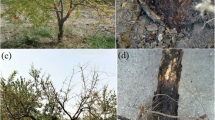Abstract
We investigated soil contamination by Spongospora subterranea f. sp. subterranea (Sss) and disease severity of powdery scab in 29 potato fields in Hokkaido, Japan, using a hydroponic culture method with tomato seedlings as bait plants. The quantity of Sss infection on the roots of bait plants was evaluated using the polymerase chain reaction (PCR) and expressed in terms of the infection potential in the soil. The infection potential was positively correlated with the disease severity of harvested tubers, whereas the spore ball density determined using PCR had an indistinct relationship with disease severity. The infection potential can be useful in evaluating soil contamination and in applying countermeasures against powdery scab.




Similar content being viewed by others
References
Asuyama H (1954) Powdery scab disease of potato (in Japanese). Shokubutsu bôeki (Plant Prot) 8:510–513
Bell KS, Roberts J, Verrall S, Cullen DW, Williams NA, Harrison JG, Toth IK, Cooke DEL, Duncan JM, Claxton JR (1999) Detection and quantification of Spongospora subterranea f. sp. subterranea in soils and on tubers using specific PCR primers. Eur J Plant Pathol 105:905–915
Bulman SR, Marshall JW (1998) Detection of Spongospora subterranea in potato tuber lesions using the polymerase chain reaction (PCR). Plant Pathol 47:759–766
Flett SP (1983) A technique for detection of Spongospora subterranea in soil. Trans Br Mycol Soc 81:424–425
Harrison JG, Searle RJ, Williams NA (1997) Powdery scab disease of potato—a review. Plant Pathol 46:1–25
Hoshino-Takada Y, Matsumoto N (2004) An improved DNA extraction method using skimmed milk from soils that strongly adsorb DNA. Microbes Environ 19:13–19
Imoto M, Iwaki M, Tochihara H, Nakamura K, Hanada K (1986) The occurrence of potato mop top virus in Japan and some of its properties (in Japanese). Ann Phytopathol Soc Jpn 52:752–757
Jones RAC, Harrison BD (1969) The behaviour of potato mop-top virus in soil, and evidence for its transmission by Spongospora subterranea (Wallr.) Lagerh. Ann Appl Biol 63:1–17
Jones RAC, Harrison BD (1972) Ecological studies on potato mop-top viruses in Scotland. Ann Appl Biol 71:47–57
Merz U (1989) Infectivity, inoculum density and germination of Spongospora subterranea resting spores: a solution-culture test system. Bull OEPP 19:585–592
Merz U (1993) Epidemiological aspects of powdery scab of potatoes caused by Spongospora subterranea. In: Proceedings of 2nd symposium of the international working group on plant viruses with fungal vectors, American Society of Sugar Beet Technologists, Denver, USA, pp 103–106
Mizuno N, Yoshida H (1994) Relationship between soil pH, exchange acidity y1 and potato scab (in Japanese). Jpn J Soil Sci Plant Nutr 65:27–33
Nakayama T, Shimanuki T (2005) Suppression of root infection by Spongospora subterranea using bacteria isolated from potato roots (in Japanese). Jpn J Phyotopathol 71:285–286
Qu X-S, Kavanagh JA, Egan D (1998) Development of specific and sensitive primers for the identification of Spongospora subterranea f. sp. subterranea. In: Gray JS, Caffrey P, Cronin D, Foley K, Ward SM, Wims P (eds) Research report 1996–1997, faculty of agriculture. University College Dublin, Ireland, pp 206–207
Qu X-S, Kavanagh JA, Egan D (2000) Quantification of the fungal cause of potato powdery scab in soil using a competitive polymerase chain reaction assay. In: Gray JS, Foley K, Monahan FJ, O’Mara FP, Ruane DJ, Ward SM (eds) Research report 1998–1999, faculty of agriculture. University College Dublin, Ireland, pp 206–207
Shimada S, Mizuno N (2000) Suppression of powdery scab disease of potato by a special fertilization method (in Japanese). Jpn J Soil Sci Plant Nutr 71:225–230
van de Graaf P, Lees AK, Cullen DW, Duncan JM (2003) Detection and quantification of Spongospora subterranea in soil, water and plant tissue samples using real-time PCR. Eur J Plant Pathol 109:589–597
van de Graaf P, Lees AK, Wale SJ, Duncan JM (2005) Effect of soil inoculum level and environmental factors on potato powdery scab caused by Spongospora subterranea. Plant Pathol 54:22–28
Wale SJ, Burgrass PJ, Burnett F (1993) Bioassay for Spongospora subterranea detection in soil and its potential use in predicting powdery scab in the field. In: Proceedings of 6th international congress of plant pathology. Forestry Canada, Montreal, Canada, p 16.4.2
Walsh JA, Merz U, Harrison JG (1996) Serological detection of spore balls of Spongospora subterranea and quantification in soil. Plant Pathol 45:884–895
Author information
Authors and Affiliations
Corresponding author
Rights and permissions
About this article
Cite this article
Nakayama, T., Horita, M. & Shimanuki, T. Spongospora subterranea soil contamination and its relationship to severity of powdery scab on potatoes. J Gen Plant Pathol 73, 229–234 (2007). https://doi.org/10.1007/s10327-007-0008-x
Received:
Accepted:
Published:
Issue Date:
DOI: https://doi.org/10.1007/s10327-007-0008-x




